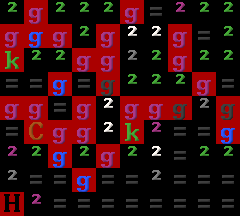- v50 information can now be added to pages in the main namespace. v0.47 information can still be found in the DF2014 namespace. See here for more details on the new versioning policy.
- Use this page to report any issues related to the migration.
v0.34:Refuse
| This article is about an older version of DF. |
Refuse is everything which can be stored in the predefined refuse stockpile (p-r). Such stockpile will accept:
- Corpses, bodyparts and bodily remains of creatures (heads, teeth)
- By-products of the meat and fishing industry (bones, raw hide, raw fish)
- Things which are rotten (rotten food, rotten meals, rotten raw hide)
- Things the dwarves have no further use for (withered plants, tattered clothes)
Uses for Refuse
Despite its name, many things considered a refuse translate into a valuable resource for dwarven industries — especially if you have modded the dwarven ethics so that you can butcher sapient creatures.
Bolts and Crossbows
Many dwarven fortresses survived the early goblin ambushes and sieges because their bone carvers used bones to make bolts. Where trees are rare, bones can serve for making crossbows as well.
Armor
Bones can be used to make bone armor. It is better than leather armor, although you cannot craft any bone breastplates, mailshirts or boots.
Leather
Pieces of armor which cannot be crafted from bones and many other useful things can easily be made out of leather. Leather is made from raw hides and raw hides are refuse. By the time you have butchered your first animal, you should have a tannery ready. The skin from butchered animals rots quickly and if you just started to butcher your numerous poultry and have a slow-working tanner, you better store raw hides in a refuse stockpile. When stored, they don't rot as quickly.
Clothes
Shearing sheep, llamas and alpacas is the very beginning of the dwarven wool industry. Their wool is more valuable than any plant fiber and is best stored in a customized refuse stockpile close to a farmer's workshop where it can be spun into yarn. The hair of other (butchered) creatures (e.g. horses or cows) can be spun into thread, too, although such threads can only be used in healthcare.
Crafts
Many, many kinds of crafts can be made from refuse. If your masons and stonecrafters work so quickly that your miners have to mine out useless space just to supply them with stones, you should consider making more crafts from refuse and refuse-based products. The choice is yours:
- yarn cloth crafts (yarn is made from wool which is refuse)
- leather crafts (leather is tanned from raw hide which is refuse)
- bone crafts
- shell crafts
- ivory crafts (teeth are considered ivory, too)
- horn crafts
Totems
The skulls of kittens, poultry and other creatures don't need to lie uselessly in your refuse stockpile. Your bonecarver can use them to make totems for which any caravan will pay you good money.
Decorations
The most valuable use for refuse is for decoration. The value of an item will multiply many times if it is skillfully decorated. Use bones, shells, ivory, and horns to decorate finished goods, clothes, or furniture. Use yarn cloth and leather (refuse-based products) to sew decorative images, too.
Refuse Stockpile
A thriving refuse-fuelled industry requires many carefully set stockpiles. A refuse stockpile works just like any other stockpile and is different from a garbage dump zone (which only accepts items explicitly marked to be dumped). The standard predefined refuse stockpile (designated by p-r) has a few peculiarities. It can become the source of miasma, if not set up properly. Under certain conditions, a refuse stockpile may become a source of great Fun, too. Therefore be advised to use customized stockpile settings instead and also be careful to avoid miasma and other potential dangers.
Avoid Miasma
Since the refuse includes rotten or rotting things, a refuse stockpile is best designated on tiles which are Light and Above Ground (see tile attributes).
Players prefer to place a refuse stockpile outside their cavern, usually a small distance from the entrance. Alternatively, you can also expose any part of your fortres's Inside Dark Subterranean tiles to sunlight and then cover them again with constructed floors or walls. Such tiles will become Inside Light Above Ground and thus the refuse stored there will not generate any miasma.
Stack and Sell Tattered Clothes
A fortress in its more advanced stages will be spammed by many tattered clothes. While some players choose to atom smash them, others still sell them for profit to caravans as they can be worth one to three quarters of their original value. To minimize the number of tiles needed to store your tattered clothes in a refuse stockpile, simply allow bins (with c or C) in the stockpile's building properties (q). Selling tattered clothes to the caravan is also a good way to solve the problem of legendary clothiers "suffering the travesty of art defacement" when their XX☼pig tail fiber socks☼XX decompose in a refuse stockpile. Note that actually leaving clothes or armor in a stockpile with refuse enabled will cause them to wear out very quickly, so if you do intend to sell these items, it would be wise to disable refuse on the stockpile once items are successfully added, since items on a stockpile tile will be considered a part of it no matter what the settings are.
Gather Refuse From Outside
Refuse stockpiles restricted to butcherable animal corpses, bodyparts, and fresh raw hides placed next to a butcher's shop or a tannery will save your butcher and tanner a lot of hauling time. A butcherable animal or bodyparts lying somewhere outside your fortress will be ignored by default unless you order your dwarves to gather refuse from outside. You can set it up in the standing orders (o-r-o).
